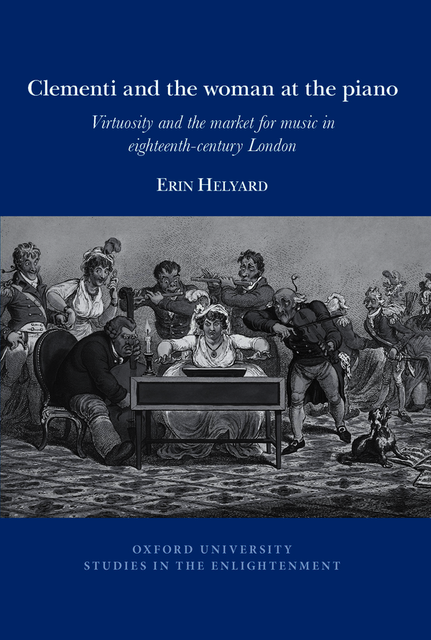This website is designed as a companion to the monograph Clementi and the woman at the piano: Virtuosity and the market for music in eighteenth-century London. Here you will find audio examples for all the printed musical examples in addition to some complete recordings that help contextualize my discussions of Clementi’s early career (Chapters 2–4), the rise of the “work-concept,” (Chapters 1, 6), the accompanied sonata in domestic settings (Chapter 5), and the importance of Op. 2 to Clementi’s legacy (Chapter 6). Some of the examples have been recorded on different instruments, to highlight the diversity of keyboard technology that existed at the time of their composition. The “Instruments” document provides details on the instruments used in the recordings.
Clementi and the woman at the piano
Virtuosity and the market for music in eighteenth-century London
Erin Helyard takes as his historical point of departure the radical appearance in 1779 of technically difficult keyboard music in a set of six sonatas (Op. 2) by Muzio Clementi. The difficult passages contained in this opus are unique amongst keyboard music published for a market that was understood at the time to consist almost entirely of female amateur keyboardists. Previously actively discouraged from practicing or improving their skills due to the restrictive ideologies in place, Clementi's music increasingly affords female pianists a new kind of musical expression.
Musical recordings and images of instruments
Consult 50 sound files (.wav format) of samples and full compositions of Clementi's music, performed in period intstruments by the author, Erin Helyard, as well as 11 illustrations of the instruments themselves.
See the text setions (above) for explanations and descriptions of the instruments and the musical compositions.
Resource Collections
Links to facsimiles of musical scores
CollectionRecordings of Clementi's sonatas
CollectionRecordings of Clementi's Op. 2
CollectionImages of Clementi
CollectionAuthor's video
CollectionRecordings of Clementi's sonatas
CollectionMusical Examples
CollectionImages of instruments
Collection
Single Resources
Introduction to the Digital Companion
Read the explanation and references for the media resources on this site.
About the digital companion
Site ContentsTexts and Media Resources
Erin HelyardTexts and media resources on this digital supplement to "Clementi and the Woman at the Piano"
- This text has 0 annotations
- This text has 0 highlights
About the Digital Companion to "Clementi and the Woman at the Piano"
Erin HelyardThis text introduces the book "Clementi and the Woman at the Piano" and the media and textual resources on this digital supplement to the book.
Published- This text has 0 annotations
- This text has 0 highlights
About The InstrumentsMusical instruments performed on the recordings for this site
Erin HelyardThis page describes the musical instruments for which Clementi composed, as performed by Erin Helyard and Melissa Farrow on the recordings for this site.
- This text has 0 annotations
- This text has 0 highlights
About the RecordingsMusical recordings discussed in "Clementi and the Woman at the Piano" available on this site
Erin HelyardRecordings of musical compostions, principally by Clementi, recorded for this site by Erin Helyard (with Melissa Farrow).
- This text has 0 annotations
- This text has 0 highlights
Print book preliminaries
- This text has 0 annotations
- This text has 0 highlights
- This text has 0 annotations
- This text has 0 highlights
Figures, Tables, And Musical Examples
Erin HelyardList of figures, tables and musical examples reproduced in the print edition.
- This text has 0 annotations
- This text has 0 highlights
Print book contents
Read the preface and table of contents to the print book.
About the digital companion
Site ContentsTexts and Media Resources
Erin Helyard- This text has 0 annotations
- This text has 0 highlights
- Published
- This text has 0 annotations
- This text has 0 highlights
- This text has 0 annotations
- This text has 0 highlights
- This text has 0 annotations
- This text has 0 highlights
Print book preliminaries
Preface
Erin Helyard- This text has 0 annotations
- This text has 0 highlights
Table Of Contents
Erin Helyard- This text has 0 annotations
- This text has 0 highlights
Figures, Tables, And Musical Examples
Erin Helyard- This text has 0 annotations
- This text has 0 highlights
Metadata
- isbn9781800856257
- publisherLiverpool University Press
- publisher placeLiverpool
- rightsWorld English language rights reserved by Liverpool University Press
- rights holderLiverpool University Press
- series number2022:06
- series titleOxford University Studies in the Enlightenment


